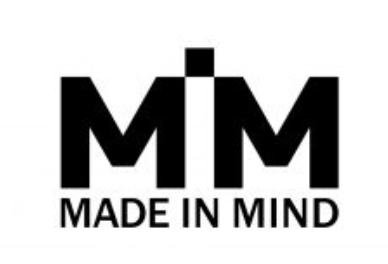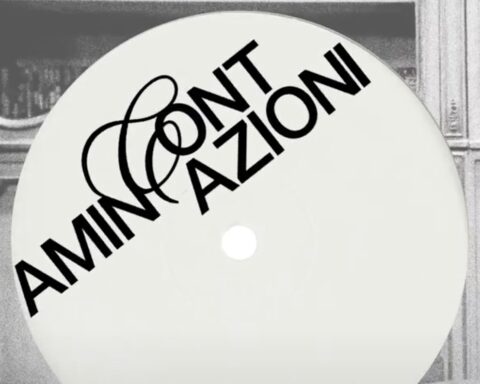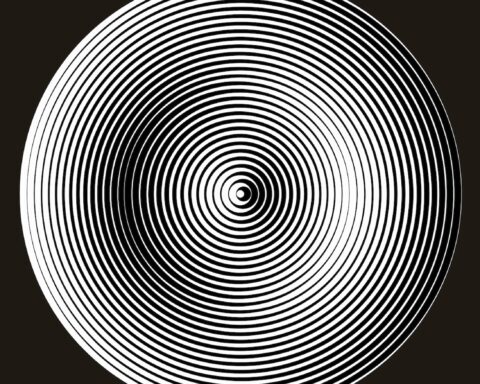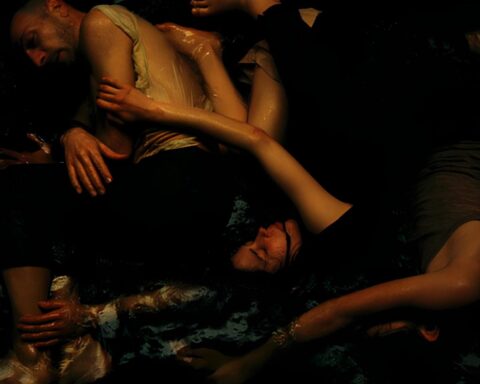Born in Birmingham in 1988, Laura Hathaway trained at Falmouth University, completing a BA in textile design with a specialisation in hand embroidery and graduating in 2011. Her journey into the art world began when she was accepted into a residency in Gloucestershire, in 2012: she had the opportunity to spend eight months with complete freedom to let go and play with materials and different processes. This experience represented, in her own words, the beginning of her evolution and discovery of abstraction. Textiles and painting are in fact two sides of the same coin: on the one side she used to work with a slow and controlled technique, on the other side she experiments through impulsive gestures. In the end, though, it is always a matter of expressing her inner world, both rational and chaotic. Stitching reflected her urge to produce perfection, but it soon became a golden cage, confining her in a rigid, controlled, almost soulless creative dimension. That was when the artist felt the need to explore her language without rules, creating some flowing, fast, messy marks. At the heart of her creative journey is also an interest and intuitive pull towards an experimental process, with an aim to challenge traditional ideas of painting and printmaking. She has always conceived her artworks as three-dimensional, creating pieces made up of multiple layers and considering shadows as another level of visual interest. Her practice finds a delicate balance between intense movement, which has some performative quality, and desire to construct something at least temporarily permanent. What she creates is a complex dreamlike world, made of glass, shadows and reflections, which has the unstable fascination of visions: they feel so real and tangible, until they vanish, recomposing themselves in a new order. Laura Hathaway exhibited regularly across the UK and had her first solo exhibit in 2016 at K6 Gallery Southampton. Her practice evolved hugely between 2016 and 2018, when she took part in the “Foal Arts” studio base, an organisation providing low cost studio and project space, encouraging innovation and sustainability within the arts. At the moment, she embraces this path of experimentation, collaborating with digital artist Julian Winslow, in order to progress her exploration into performance.

Photo by Julian Winslow. The Depozitory, Isle of Wight, UK 2017
Flavia Rovetta: What impact does the artistic creation have on your life? How did you understand that the best way to relate with the outside world was to give voice to your creativity?
Laura Hathaway: The assembly of marks and materials is an outward reflection of an innate need to communicate an internal nature. I make because of a need to create, to express and to make sense of internal thoughts and feelings through a tangible thing. The work is a messy, physical expression through paint and colour, followed by an attempt at creating a sense of calm, order, balance and precision within life’s chaos. An extended communication and understanding with myself rather than making for an audience.
Painting directly onto a surface with my hands, the physicality of pressing, smearing and transforming ink, glass and paper, captures intense feelings and movements. Probing expressive potential and the role of chance, the works transform through unexpected and accidental outcomes. The work is a juxtaposition between spontaneity, chaos and my own feeling for a need for control.

Moon ate the dark (detail)
3D Painting Etching ink, pigment, copperplate oil, reflective picture framing glass Photo by Julian Winslow The Depozitory, Isle of Wight, UK 2017
F.R. Could you describe your artistic process in all its evolution?
L. H. It felt natural for me to progress from textiles to painting. Stitch was so slow and restrained, I felt an urge and complete need to create flowing, fast, chaotic, messy marks.
I began to challenge and focus my process of abstract, emotion driven mark making in paint and pigment onto glass and paper, recording the process, exploring elements of performance. The works examine the properties and absorbency of paints, pigments and oils against surfaces, focusing in on the effects of layering, opacities and manipulation.
Exploring mark making as a material product of the body, creating organic and delicate compositions, the role of the unconscious is paramount to my process, which is intuitive, intense and spontaneous. These abstract expressions are finally put through a process of assemblage which, over time, has evolved into a ritualistic technique of placing elements of wood, paper and glass together, repeatedly moving and re-adjusting materials before finally settling on a composition.
F.R. Looking at your artistic path, on the one hand we can think of the great American abstraction, on the other hand we can think of graffiti and street art. What are your artistic and cultural references? Are there any artists that you feel close to, as if they were some kind of “spiritual fathers”?
L. H. I’m always inspired by both consciously and unintentionally made abstract shapes that I come across in my surroundings. In particular, I love the marks made by people wiping condensation from the insides of bus and car windows. The way the moisture is pushed from side to side and in circular motions then the liquid drips down, pulled by gravity. It was noticing the way the water interacted with the glass which made me first begin experimenting with pigments and oil on glass panels. I started pushing and smearing paint with the abstract drips and flecks of windows in mind which then led on to more emotion driven mark making.
I also love finding graffiti cover ups. When someone for whatever reason smears or scribbles over another’s piece, sometimes leaving behind a pigmented finger or hand print.
Alongside the splatters, scribbles and smudges I come across walking or travelling I feel a great affinity with artists such as Cy Twombly, Rothko, Yves Klein and Ushio Shinohara.
I don’t necessarily look for inspiration or ideas from these artists rather I feel a deep connection with their mood, quality of line, senses and expression through abstraction. The scale, action within and intensity of their work moves me.

BLACK
3D Painting. Pigment, oil, Japanese papers, glass, obeche, emulsion Photo by Julian Winslow
F.R. What value does the transparency of glass have for you? Does it symbolise an open window on your inner world or is it rather the desire to include the outside world in your creative universe?
L. H. I began exploring transparency and the effects of glass with a series of paper works. Soaking and smearing different kinds of translucent papers in pigments, inks and oils. Once dry, I placed them together in geometric compositions and pressed them between glass. Painting directly onto glass was an accidental evolution within my practice. It came at a time where I felt a huge emotional energy coursing through me, a real need to express an internal dialogue where communication through words failed me. Once I had started smearing marks onto the glass I couldn’t stop. The directness captured the immediacy, intimacy and intensity of the marks, strong gestures and shapes emerging. Once dried and settled I began reflecting on my creations, placing the glass panels together, perhaps trying to make sense of the things I had made, to balance the chaos of the initial making. It filled me with a sense of calm, positioning and finding which marks interacted and partnered with another.
The transparency of the glass has become a tool to be able to layer up marks. It gives me the ability to interchange panels and layers, to find gestures that work together. To play with height, to move pieces around, to interact with light and shadows.
It also allows me to completely change a painting if six months down the line the balance has changed for me. I can re-imagine and create a whole new piece by interchanging the glass and adjust pieces according to the space they are to sit within.

F.R. The titles of your artistic production have some mysterious and disturbing elements. It is as you are constantly trying to hold off your demons. Could you explain what happens in My brain is eating my head?
L. H. All my gestural paintings are created and fuelled by an emotional trigger attached to music. It opens up something within me that feeds my ability to create and express an internal energy. Titles of works are often formed from the song lyrics I have been listening to, that have spoken to me and expressed something through words that I could not find the words to say myself. I often get overwhelmed with thoughts and in the moment I made the marks in this painting it felt like my mind or my brain was eating into me. My thoughts were overtaking my life and devouring my soul. The marks felt like a visual representation of the thing I was going through at the time and so My brain is eating my head was formed to communicate this and relieve myself from an internal build-up of emotional angst.
F.R. How important is the unconscious and surreal element in your work? Does the sign spontaneously manifest itself or is it rather a controlled, rationalised gesture?
L. H. The process of making paintings for me, is a combination of unconsciously and consciously made gestures and movements. The first part is messy, uncontrolled, free and mostly unconscious. Driven by an emotional release or communication. Painting directly onto surfaces with my hands, removes for me an element of thought. My hand moves from paint to surface with fluidity and immediacy.
The second part, after the paint and pigments have dried is rationalised and controlled. It has become a ritualistic, calming process of moving and re-adjusting panels before finally settling on a composition. The chaos and control are both equally important within my practice, as ultimately I am searching for balance. The juxtaposition and tension between mess and order is necessary to reach this point of harmony and satisfaction.

F.R. Your sign is, at the same time, flat and three-dimensional, concrete and illusory. On the one hand there are pigments on the surface, on the other hand there are shadows and reflections. How do these two different faces of reality interact in the artwork Moon ate the dark?
L. H. Moon ate the dark was commissioned for an exhibition in an old Wesleyan Methodist Church. The building had huge imposing windows running the length of the chapel, reaching nearly the height of the ceiling. A large circular glass window overlooked the front of the building. Again for me, I conceived the work to form a balance. Using the painted marks on glass, I created the piece in response to the space I was allocated, the light in the building and how the marks interacted with each other in that space. I was also very conscious of the other exhibiting artist’s work and how the piece interacted with their own creations. And so Moon ate the dark was formed. It was only after making the work and participating in a public talk led by artist and lecturer Jonathan Parsons, that the importance of the interaction of the architecture within the building became apparent. In placing my glass panels in their composition I had mimicked the curves and lines within the windows throughout the piece. The reflection of the elongated windows mirrored my semi-circle smears and was emulated further by my large rectangular dense smudges of black ink. The building and Moon ate the dark became fused as one piece. Shadows, paint and reflections influencing and merging with one another.
F.R. The artwork DISORDER II, is a small room of wonders, but at the same time it seems to me a sort of psychedelic prison. What is the origin of this colourful chaos, in which even people appear as abstract spots?
L. H. I had previously created a three-dimensional painting in a phone box called K6 Gallery, titled DISORDER. DISORDER II was a progression and continued evolution, investigating further how I could create my gestural marks within a three-dimensional glass form. The greenhouse lent itself to my own exploration and the project. For this piece, as it was a ready-made static form, I could not move the panels around after painting to find the usual balance. However, the scale and levels within the structure meant that I was able move throughout and paint freely. Flowing around the form, consciously sensing which marks interacted and balanced the next. There was also a great freedom working in a 360-degree surface area. The photography of the piece by Julian Winslow added another layer of interest, with people and lights turning into blurs and smudges, mimicking the painterly marks, flecks and splodges covering the interior and exterior of the glass. The piece was displayed and transported through a carnival, enhancing the colourful chaos, with much bewildered response.
F.R. Your artwork The World We Made Has Been Ending predicts an apocalyptic destiny, which is already underway. What do you think it could be the destiny of painting in today’s society?
L. H. Despite my apocalyptic prediction within this particular piece of work, I truly believe that humans will always feel the need to express, to tell a story, to make marks and to paint. It is part of our innate nature to communicate through a visual language.







